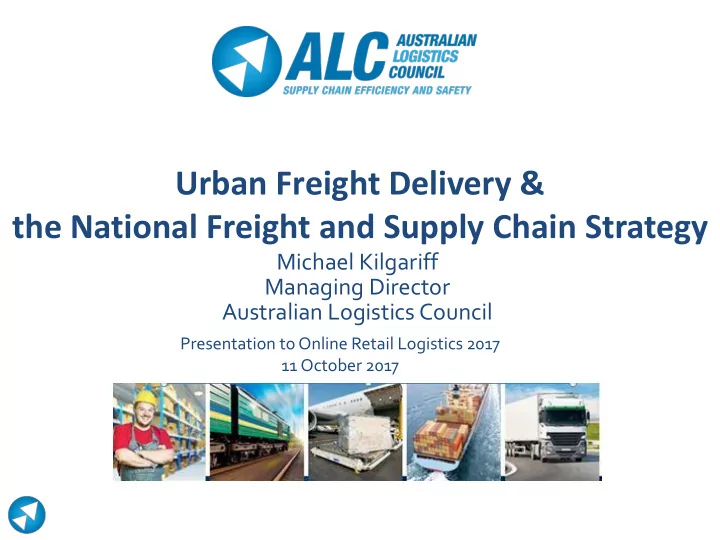

Urban Freight Delivery & the National Freight and Supply Chain Strategy Michael Kilgariff Managing Director Australian Logistics Council Presentation to Online Retail Logistics 2017 11 October 2017
The Australian Logistics Council
The Australian Logistics Council
The National Freight and Supply Chain Strategy ALC’s top priority before the 2016 election campaign was the completion of a National Freight and Supply Chain Strategy . This strategy has also been recommended by Infrastructure Australia. Prime Minister Malcolm Turnbull announced such a Strategy would be developed in November 2016. Work is now underway.
The Australian Logistics Industry Adds more than $130 billion to the Australian economy each year. This represents 8.6% of Australia’s GDP . Employs 1.2 million Australians. Every 1% efficiency improvement boosts GDP by $2 billion .
Freight Doesn’t Vote In August, ALC released its final submission to the Inquiry that is helping to shape the Strategy. Our submission’s content was informed by extensive and in- depth industry consultations . Submission makes 41 key recommendations .
The Impact of Urbanisation in Australia Australia is heavily urbanised – 90% live in cities (higher than both USA and China). Commodities must be transported to consumers – increasing numbers of whom live in CBD/inner city apartments. Road congestion is an irritant to commuters – but it is also affecting the prices consumers pay for goods . Also adds to business costs for freight logistics operators.
Challenges to overcome Congestion is not just an inconvenience, but a cost . Already costing $16 billion per year – and rising. Freight task will grow 26% in next decade . Virtually all public policy discussion re. congestion focusses on demand management – tolls and congestion charges. These tools alone aren’t the answer.
Road Pricing Reform We must reconsider not just the way we use roads, but the way we price roads. Need a fairer, more efficient approach where users pay according to where and when they travel. Technology such as GPS tracking makes this possible. Will have to apply to all vehicles – not just heavy and commercial vehicles . Independent regulation for pricing can build confidence .
Our economy is national Freight does not stop at state borders. The regulatory structures that govern freight movement must be nationally consistent . Federal Government can play a greater role in planning, by incentivising good practices and encouraging the removal of restrictive measures, such as curfews. Ultimately, this feeds into the prices paid for goods by businesses, and consumers .
CBD Freight Delivery Road space in CBD areas is already at a premium. Numerous examples of large scale sites being developed with inadequate freight delivery facilities . Lack of consultation over the positioning (or removal) of CBD loading zones . Need to consider forms of freight-only infrastructure , as well as reverse curfews .
Using technology to improve visibility Use of global data standards (GDS) has been shown to enhance visibility and traceability of freight. Allows all parties in the chain to access real-time information to control and manage processes effectively. Assists in meeting consumer expectations.
Barriers to uptake of technology Continuing industry perception that the cost outweighs the benefit . Lack of bespoke IT systems and non- standard data formats - and a lack of collaborative mindset . Smaller companies often lack the resources and capacity to implement new approaches.
The National Freight and Supply Chain Strategy – where to from here? The Federal Government is expected to release a draft report in December 2017. Final report is expected in March 2018 . We anticipate the release of the final National Freight and Supply Chain Strategy prior to the next Federal Budget in May 2018 .
Recommend
More recommend